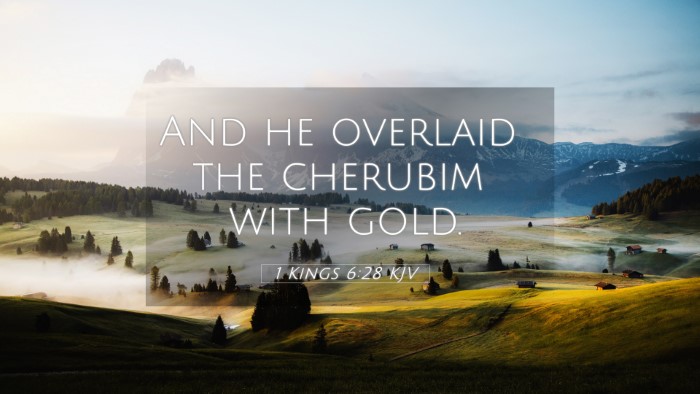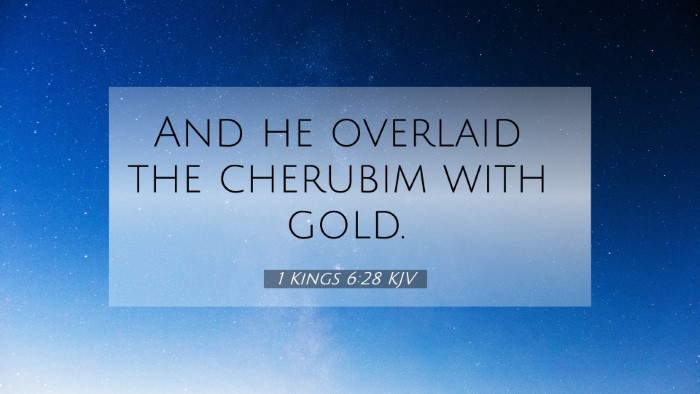Understanding 1 Kings 6:28
The verse 1 Kings 6:28 states: "And he overlaid the cherubim with gold."
This verse is part of the account of the construction of Solomon's temple, specifically detailing the adornment of the cherubim located in the inner sanctuary. To grasp the significance and implications of this verse, we can draw insights from various public domain commentaries, which explore its theological and historical implications.
Contextual Overview
1 Kings chapter 6 describes the intricate details of Solomon's temple, showcasing the beauty and craftsmanship employed in its construction.
The cherubim, angelic beings, symbolize the presence of God and serve as guardians in the divine realm.
Commentary Insights
Matthew Henry's Commentary
Matthew Henry notes the symbolic significance of the gold overlay on the cherubim, emphasizing that it reflects the divine glory and majesty of God.
Henry explains that the cherubim represent the guardianship of God over His people, and the gold signifies purity and perfection.
The temple, adorned with opulence, was a testament to Israel's reverence for God and the importance of worship within the nation.
Albert Barnes' Notes
Albert Barnes highlights the dimension of craftsmanship involved in the creation of the cherubim. He suggests that the artistry was not only for aesthetic purposes but also to communicate the holiness of the worship that would occur within the temple.
Barnes also draws connections to the cherubim's representation of divine protection, suggesting that their presence in the temple serves as a reminder of God's glory and providence.
Adam Clarke's Commentary
Adam Clarke addresses the historical context of the cherubim, referring to their placement in the Holy of Holies. He notes that these figures were designed to reflect God’s covenant with His people.
Clarke elaborates on how the gold overlay symbolizes not only wealth but also the divine light and holiness that God emanates.
The cherubim's position signifies their role as intermediaries, indicating that God is always aware and present among His people.
Theological Significance
- Divine Presence: The cherubim represent God's abiding presence among His people, urging them to reflect on their relationship with Him.
- Importance of Worship: The temple's design and adornments emphasize the centrality of worship in Israelite life.
- Symbol of Protection: Through the cherubim, the text illustrates God's protective nature over His covenant community.
- Beauty in Holiness: The gold overlay signifies the beauty and worthiness of God's holiness, inviting the people into reverence.
Cross-References and Bible Connections
To deepen our understanding of this verse, we can explore related passages that provide thematic and contextual links. Below are key cross-references:
- Exodus 25:18-20: Describes the construction of cherubim for the mercy seat, emphasizing their role in the presence of God.
- 2 Chronicles 3:10: Provides parallel details about the construction and design of the temple cherubim.
- Isaiah 6:2: Refers to seraphim, indicating that heavenly beings surround God's throne, echoing the significance of divine presence.
- Revelation 4:6-8: Highlights the worship around God's throne, showcasing a continued theme of celestial beings interacting with God's holiness.
- Exodus 26:1: Discusses the curtains and the glory of the Lord; linking fabric adornment to divine presence.
- Hebrews 9:5: Refers to the cherubim of glory overshadowing the mercy seat, establishing a connection to New Testament theological themes.
- Psalm 99:1: Speaks of the Lord reigning; the imagery connects to the exaltation and purity of His temple.
- Ezekiel 10:1-20: Offers an elaborate vision of cherubim in the temple context, highlighting the significance of these heavenly beings.
- Luke 1:19: Mentions Gabriel, an angel, showing that God's messengers also play critical roles between heaven and humanity, akin to the role of cherubim.
- Philippians 4:19: Links God’s provision and glory to His people, drawing parallels with the opulence of the temple.
Conclusion
In conclusion, 1 Kings 6:28 serves as a poignant reminder of God’s glorious presence among His people, framed by rich theological themes surrounding worship, the divine nature, and biblical symbolism.
The insights from the commentaries provide layers of understanding, while the cross-references reveal connections that enhance our study of Scripture.
Whether through comparative Bible verse analysis or thematic Bible verse connections, this verse stands as an integral part of the biblical narrative, inviting reflection and reverence.


